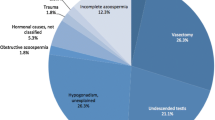Abstract
Purpose: Our purpose was to evaluate whether the source of spermatozoa influences the results of intracytoplasmic sperm injection (ICSI) treatment in couples with severe malefactor infertility.
Methods: A retrospective analysis of 40 cases of ICSI with testicular-retrieved spermatozoa, matched with 40 cases of ICSI with ejaculated spermatozoa, was performed. We included only couples with normoovulatory females younger than 37 years who were matched according to the day of ovum pickup with the patients in the study group.
Results: Eighty cycles were analyzed: 40 cycles using testicular spermatozoa and 40 cycles using ejaculated spermatozoa. In 32 (80%) of the 40 ICSI transcutaneous needle aspiration cycles, we obtained enough spermatozoa to inject all the mature oocytes retrieved. In eight (20%) cases there were not enough spermatozoa to inject all the oocytes. Only 76 (54%) of 141 available oocytes were injected in these eight patients. The oocyte fertilization rates were 42% for the study group and 55.5% for the controls (P < 0.005). Thirty-six (90%) patients in the group with nonobstructive a zoospermia (NOA) and 37 (92.5%) patients in the oligoteratoasthenospermia (OTA) group had embryos for replacement. The mean cleavage rates per cycle (96% with tasticular and 93% with ejaculated spermatozoa), the mean number of embryos per transfer (3.72 ± 1.6 in the NOA group and 4.24 ±1.5 in the OTA group), the embryo quality (cumulative embryo scoring = 34.03 ± 22.62 in the testicular sperm group and 36.08 ± 19.28 in the ejaculated sperm group), and the clinical pregnancy rates (22.5% in the NOA patients and 20% in the ejaculate group) were not significantly different between groups.
Conclusions: High fertilization, cleavage, and pregnancy rates can be achieved with intracytoplasmic testicular sperm injection from patients with NOA, reaching levels comparable with those of ICSI using ejaculated spermatozoa.
Similar content being viewed by others
REFERENCES
Palermo G, Joris H, Devroey P, Van Steirteghem AC: Pregnancies after intracytoplasmic injection of single spermatozoon into an oocyte. Lancet 1992;340:17–18
Nagy ZP, Liu J, Joris H, Verheyen G, Tournaye H, Camus M, Derde M-P, Devroey P, Van Steirteghem AC: The results of intracytoplasmic sperm injection is not related to any of the three basic sperm parameters. Hum Reprod 1995;10:1123–1129
Devroey P, Liu J, Nagy Z, Goossens A, Tournaye H, Camus M, Van Steirteghem AC: Pregnancies after testicular sperm extraction and intracytoplasmic sperm extraction in nonobstructive azoospermia. Hum Reprod 1995;10:1457–1460
Madjar I, Seidman DS, Levran D, Yonish M, Augarten A, Yemini Z, Mashiach S, Dor J: Micromanipulation improves in vitro fertilization results after epididymal or testicular sperm aspiration in patients with congenital absence of the vas deferens. Hum Reprod 1996;11:2151–2154
Schoysman R, Vanderzwalmen P, Nijs M, Sigal L, Sigal-Bertin J, Geerts L, van Roosendaal E, Schoysman D: Pregnancy after fertilization with human testicular spermatozoa. Lancet 1993;342:1237
Nagy ZP, Liu J, Janssenwillen C, Silber S, Devroey P, Van Steirteghem AC: Using ejaculated, fresh, and frozen-thawed epididymal and testicular spermatozoa gives rise to comparable results after intracytoplasmic sperm injection. Fertil Steril 1995;63:808–815
Shulman A, Ben-Nun I, Ghetler Y, Kaneti H, Shilon M, Beyth Y: Relationship between embryo morphology and implantation rate after in vitro fertilization treatment in conception cycles. Fertil Steril 1993;60:123–126
Dor J, Ben Shlomo S, Lipitz S: Ovarian stimulation with gonadotropin releasing hormone (GnRH) analogue improves the in vitro fertilisation (IVF) pregnancy rate with both transvaginal and laparoscopic oocyte recovery. J In Vitro Fert Embryo Transfer 1990;7:351–354
Silber SJ, Van Steirteghem AC, Liu J, Nagy Z, Tournaye H, Devroey P: High fertilization and pregnancy rate after intracytoplasmic sperm injection with spermatozoa obtained from testicle biopsy. Hum Reprod 1995;10:148–152
Nijs M, Vanderzwalmen P, Vandamme B, Segal-Bertin G, Lejeune B, Segal L, van Roosetdaal E, Schoysman R: Fertilizing ability of immotile spermatozoa after intracytoplasmic sperm injection. Hum Reprod 1996;11:2180–2185
Author information
Authors and Affiliations
Rights and permissions
About this article
Cite this article
Hourvitz, A., Shulman, A., Madjar, I. et al. In Vitro Fertilization Treatment for Severe Male Factor: A Comparative Study of Intracytoplasmic Sperm Injection with Testicular Sperm Extraction and with Spermatozoa from Ejaculate. J Assist Reprod Genet 15, 386–389 (1998). https://doi.org/10.1023/A:1022537117578
Issue Date:
DOI: https://doi.org/10.1023/A:1022537117578




